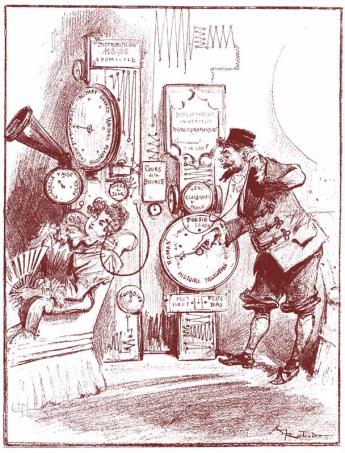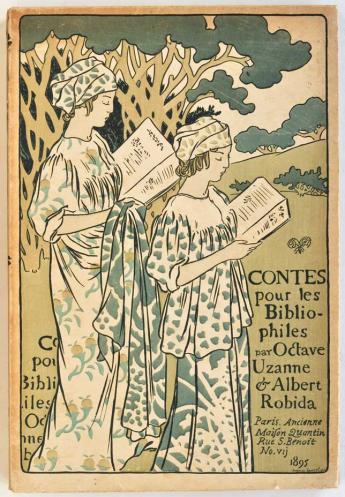Antiquarian Booksellers' Association Justin Croft Antiquarian Books Ltd
1895 la fin des livres?

By Justin Croft
She’s relaxing on the sofa with her headphones on; her friend is listening to a novel. Between them they can get hold of pretty well anything they choose to hear – literature or music – channel-hopping from dance to Wagner to poetry or from philosophy to novels. The year is 1895 and the days of reading from printed books seem to be numbered.
At the dawn of the electrical age the Parisian publisher and dandy Octave Uzanne and his friend, Albert Robida, a science-fiction author and illustrator, imagined a new literary world. The printed book was replaced by a subscription service where access to books and music was provided in the home with electrical gadgets wired to a central network.
Those without the necessary equipment at home were not excluded and could get pay-as-go access from listening points in public places or on public transport. Libraries were repositories for recorded sound, and books existed as audio recordings, preferably in the voice of their author. Uzanne and Robida’s fantasy was published as ‘La fin des livres’ in Contes pour les Bibliophiles (1895).
Uzanne was a bibliophile who foresaw the potential of electronic publishing. But he also saw that printed books could survive in the coming era by becoming objects of desire. He understood that reading was not just an intellectual activity and he set about creating books which were not only beautiful, but which took delight in doing things that only books could do. He relished the power of the well-designed cover and the excitement it brought to the opening of a new book for the first time. He sometimes added extra jackets in embroidered silk with ribbons and laces to be untied.
Texture was important. Paper was carefully chosen and decorative tissue guards protected the many illustrations to provide a whispered rustle as the images were revealed. Text and illustration were luxuriously combined on almost every page. His books were the bibliophilic equivalent of a collector’s vitrine, stuffed with exotic (and sometime erotic) exhibits in a heady mixture of graphic styles.
Octave Uzanne was not sentimental about his books. They didn’t, for example, hark back to an imagined golden age, and his project was entirely different from the Arts and Crafts movement across the English Channel which was busily recreating the book arts of the past. Uzanne loved technology as much as his sci-fi friend Robida.
The two of them haunted the Paris Expositions looking for new printing techniques to perfect their colour plates. While their books were designed to appear exotic and exclusive, they were affordable and widely available. Certainly editions were limited, but they ran to 1000 or more copies in most cases.
These works are steeped in the fin-de-siècle Paris scene but some of Octave Uzanne’s thoughts and predictions on the relationship between print and changing communication technologies have become relevant to today’s ‘death of the book’ debates and to contemporary developments in publishing.
Justin Croft has put together a catalogue of 10 characteristic works by Uzanne, which can be downloaded as a pdf here.
If you’d like to read more there is an excellent book on the Parisian bibliophilic scene of the 1890s, with lots of material on Octave Uzanne: The New Bibliopolis. French Book Collectors and the Culture of Print 1880-1914 by Willa Silverman (University of Toronto Press, 2008).
(Posted on the website of the Antiquarian Booksellers‘ Association (ABA). Presented here by permission of the author.)
Octave Uzanne's "End of Books" in Scribner's Magazine 1894
>>> Click here to read the full text
(Courtesy of David Aronovitz)
You are collecting Octave Uzanne’s works?


